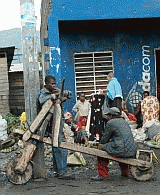Putting the sordid, sensational, and squalid (his) story of “conservation” in the Great Lakes Region of Central Africa under the monkey scope, CARE International’s foray into the environmental scene in Uganda has remarkable similarities to the Conservation International, CARPE and Dian Fossey Gorilla Fund International landscape projects in the Democratic Republic of Congo (DRC) today.
One can argue that the Road to Tayna began in little Mgahinga Gorilla Park, in 1993. The Hanged Man and the Mwami of our series both had remarkable tales to tell, but only the Congolese Mwami lived to tell his. Meanwhile, in 2004 USAID was telling Congress another story altogether—a story contradicting the press releases, propaganda and out right lies propagated by wildlife organizations in and around Virunga National Park and the CARPE landscape partners in pork.
For our international readers, the terms “pork” and “pork barrel” refer to government excess in spending that benefits the constituents of a politician or some private entity. The term originated on U.S. slave plantations where the slaves were given the dregs of slaughtered pigs—what remained in the “pork barrel.”
The “pork” terminology gains new meaning when we examine and comprehend the DFGF-I “Pigs for Profit” program from the Tayna Conservation area.
The Weidemann Report
In a telling memo written in December 2004, Robert Hellyer—USAID Mission Director for DRC—wrote to the USAID Africa Bureau in Washington regarding the Central Africa Regional Program for the Environment (CARPE), the “principal vehicle for United States participation in the Congo Basin Forest Project.”
“Of the more than 60 million people that live in the region,” Hellyer wrote, “about 22 million are located in urban areas. At present rates of population growth, the region is expected to contain 150 million people by the year 2025. Population density is on the whole quite low, with a regional average of 14 persons per square kilometer. ”(1)
There it is. Buried in the February 2006 Annex of the supporting documents for the report of the Weidemann Consortium—an evaluation of the CARPE program in Central Africa—is the admission that the rational of “overpopulation” was bogus. For all the satellite sensors, the population control programs, the hand wringing by UNESCO and Conservation International and Fauna and Flora International and Richard Leakey’s ranger-training operation called Wildlife Direct—the alphabet soup of BINGOs and DINGOs gathering like hyenas for the kill around the perimeter of Virunga and Kahuzi-Biega National Parks—“the population density is on the whole quite low.” (2)
Robert Hellyer elaborates on the global demand for petroleum and timber, and on the adverse impacts of human populations in a landscape—Congo—where “it is in the self-interest of the United States government” to support “sustainable development” in the region. Hellyer confirmed that CARPE and USAID are not interested in the Congolese people, or even biodiversity protection, but only in the interests of the United States.
How many of the claims of the BINGOS—the big conservation NGOs—are real and how many public relations? They all claim community partnerships and sustainable development, but what is the situation for the people on the ground in Central Africa?






